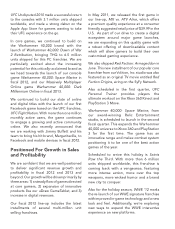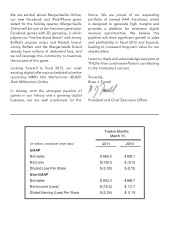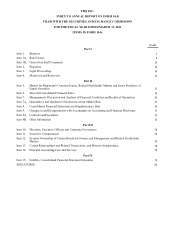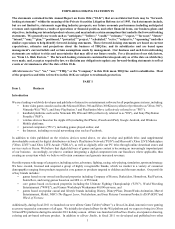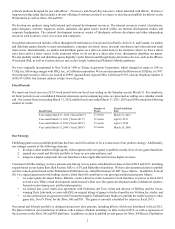THQ 2011 Annual Report Download - page 13
Download and view the complete annual report
Please find page 13 of the 2011 THQ annual report below. You can navigate through the pages in the report by either clicking on the pages listed below, or by using the keyword search tool below to find specific information within the annual report.
In addition to creating and acquiring our owned intellectual properties, many of our titles are based upon licensed properties that
have attained a high level of consumer recognition or acceptance. We have relationships with many well-known licensors and
create games based on certain properties they own or control. Licensors generally do not grant exclusive output agreements for
all of their properties with any one publisher and thus our licenses are limited to certain of a licensor's properties. Our current key
licenses allow us to publish games based on the following properties:
/LFHQVRU
&XULRXV+ROGLQJV
'LVQH\DQG'LVQH\3L[DU
'UHDP:RUNV$QLPDWLRQ
*DPHV:RUNVKRS
0DUYHO(QWHUWDLQPHQW
0DWWHO
1%&
1LFNHORGHRQ
6RQ\3LFWXUHV&RQVXPHU3URGXFWV
7ZHQWLHWK&HQWXU\)R[
:RUOG:UHVWOLQJ(QWHUWDLQPHQW
=XIID//&
3URSHUWLHV
Video games based on the teachings of Deepak Chopra, M.D.
"Ratatouille," "WALL•E," "Up," “Brave,” “Disney Princess”
"Megamind," "Kung Fu Panda 2," "Puss In Boots," and "The Penguins of Madagascar"
Warhammer 40,000 universe content
"Super Hero Squad"
“Pictionary,” “Barbie,” “Hot Wheels” and additional Mattel brands
"The Biggest Loser"
"SpongeBob SquarePants"
"JEOPARDY!" and "Wheel of Fortune"
“Rio”
World Wrestling Entertainment content
Ultimate Fighting Championship content
These intellectual property licenses generally grant us the exclusive use of the property for specified titles, on specified platforms
and for a specified license term. The licenses are of varying duration, and we pay royalties to our property licensors generally
based on our net sales of the title that includes the licensor's intellectual property. We typically advance payments against minimum
guaranteed royalties over the license term. Royalty rates are generally higher for properties with proven popularity and less
perceived risk of commercial failure.
'HYHORSLQJ2XU3URGXFWV
We develop our products using both internal and external development resources. The internal resources consist of producers,
game designers, software engineers, artists, animators and game testers located within our internal studios located throughout
North America, the United Kingdom, Australia, and in our corporate headquarters. The external development resources consist
of third-party software developers and other independent resources such as artists, voice-over actors and composers.
We make the decision as to which development resources to use based upon the creative and technical challenges of the product,
including whether the intellectual property being developed into a game is licensed, an original concept that we created, or an
original concept created by a third-party developer. Once we determine where a product will be developed, our product development
team oversees the internal or external resources in its design, technical assessment and construction of each game.
The development cycle for a new game depends on the platform and the complexity and scope of the game. Additionally, when
developing an intellectual property into a game that is simultaneously being made into a motion picture, our development schedule
is designed to ensure that our games are commercially available by the motion picture's theatrical release. Our development cycles
generally range as follows:
• 12-36 months for our console and PC games;
• 9-18 months for our handheld games;
• 6-18 months for our casual/social online games; and
• 1-5 years for our core online games (with the longer end of that range for our large scale MMO games).
These development cycles require that we assess whether there will be adequate retailer and consumer demand for a game and
its platform well in advance of its release.
The investments in our product development, prior to when a game reaches technological feasibility, and other non-capitalizable
costs, are recorded as product development expenses in our consolidated statements of operations. In fiscal 2011, 2010, and 2009,
we had product development expenses, net of amounts capitalized, of $79.4 million, $87.2 million, and $109.2 million, respectively.
4


